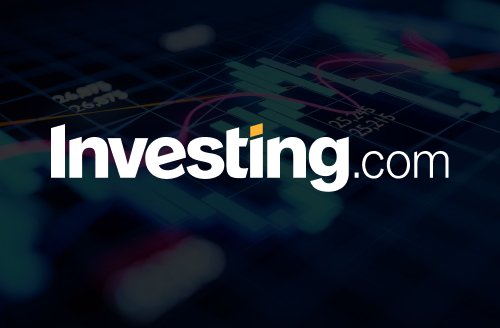Trade deals, tariff fireworks, data drama, this week has had it all. Here are four key takeaways from this whirlwind week – and what we’ll be watching as the story unfolds in the days to come.
Tariffs Haven’t Changed as Much as You Might Think
Last week, I asked the question of whether the 1 August trade deadline would look any different to the ultimatums that have come – and gone – before it. I was sceptical – and it looks like I was right to be. Because for all the various announcements on tariffs made by the US administration this week, not much has tangibly changed. Not so far, anyway.
Take the EU deal. Car tariffs are down from 25% to 15%. And the baseline tariff is up from 10% to 15%, but crucially, this new rate no longer stacks on top of the circa 1.5% average tariff the EU was subject to before US President Donald Trump’s inauguration.
Throwing all of that together, I calculate that the average tariff across everything the US imports from the EU has risen from 12.9% to 13.4% after this week’s deal. Which is, quite literally, a rounding error.
Now, you’ll have noticed I haven’t talked about pharmaceuticals here. The EU deal does, in theory, include a 15% tariff on the sector, as it does for chips and presumably a whole raft of other sectors currently excluded from the reciprocal tariffs globally. Bundle that in, and the average tariff on the EU does rise more precipitously.
But we still don’t know when – or frankly if – these pharma duties will ever kick in. Or if the deal is subject to quarterly reviews by the US administration, as Treasury Secretary Scott Bessent has hinted. Or how strictly the US will enforce the energy purchase and investment commitments made by Europe and others, which could prove a future flashpoint.
Those are just some of the many unanswered questions from this week’s deals. And that’s a problem, because the main (and perhaps the only) advantage for Europe of signing the deal this week was that it would reduce uncertainty for businesses and consumers. I’m not convinced that is the case – and my eurozone colleagues continue to predict lacklustre growth figures for the rest of this year.
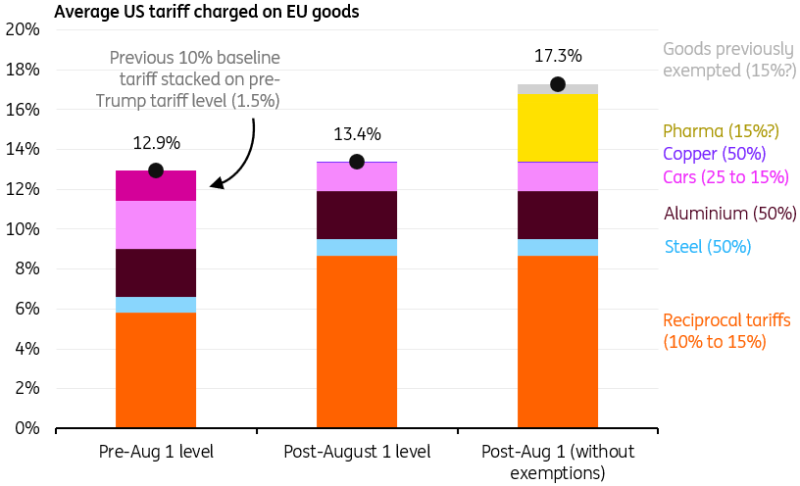 Ignoring pharma, the EU’s tariff rate has barely increased post-trade deal.
Ignoring pharma, the EU’s tariff rate has barely increased post-trade deal.
The US Jobs Market Isn’t Nearly as Strong as We Thought
When it comes to the jobs market, everything changed this week. Markets certainly think so, anyway. Investors are pricing a 93% chance of a September rate cut from the following a surprisingly weak , up from 44% just hours earlier.
James Knightley has all the gory details, but the headline is that May and June’s job data saw massive downward revisions, such that non-farm payrolls barely increased in either month. When the data is eventually revised again to better align with tax records, it may well be that these months saw net job losses. And that appears to pull the rug from under Fed Chair Jerome Powell’s assertion this week that the jobs market hasn’t weakened over recent months.
But Powell also told us that he doesn’t think the payrolls data is necessarily that helpful right now, and instead, we should all be looking at the . The idea is that employment growth could be lower simply because the workforce is increasing more slowly – an artefact of US immigration policy – and not necessarily because hiring demand is falling.
Clearly, that can’t explain the full weakness in non-farm payrolls through May and June. But by Powell’s logic, the Fed may be less fazed by these jobs figures than we might think. And on his preferred metric of the unemployment rate, yes it did rise in July, but it has been basically flat for the past year.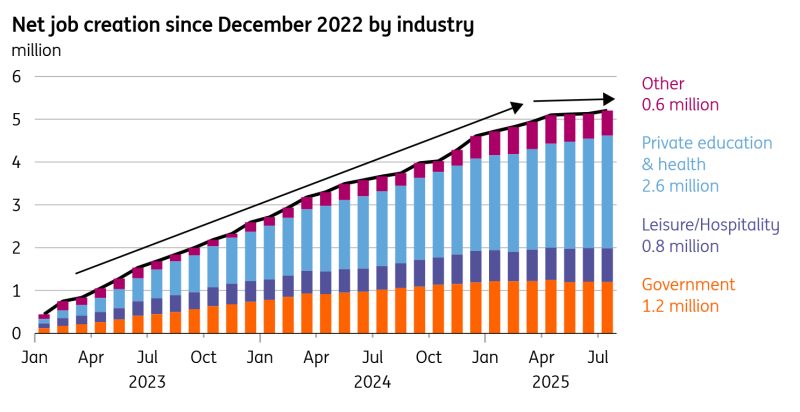 As James K writes, a lot now rests on the next jobs report in early September. And as he says, regardless of when the Fed does start cutting rates, recent history tells us that it could be forceful once it gets going. Remember last year’s swift 100bp bout of rate cutting was in direct response to a rise in unemployment early last summer.
As James K writes, a lot now rests on the next jobs report in early September. And as he says, regardless of when the Fed does start cutting rates, recent history tells us that it could be forceful once it gets going. Remember last year’s swift 100bp bout of rate cutting was in direct response to a rise in unemployment early last summer.
Tariffs Are Starting to Show Up in US Inflation
This latest jobs bombshell certainly questions whether the Fed has the luxury of time to focus on what is expected to be a hot summer of US .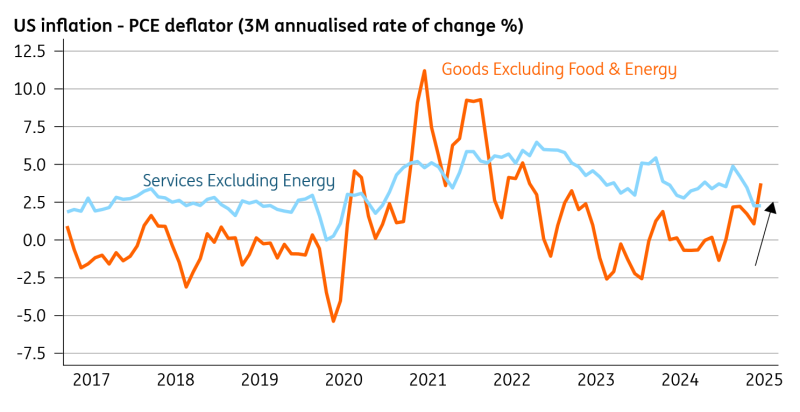
James Knightley has long argued that the tariffs would hit inflation with a lag. And that does seem to be what is happening. This week’s , the Fed’s preferred way of looking at inflation, shows goods inflation at almost 4% if we look at the annualised change over the past three months. That could still rise much further this summer. And for all the drama surrounding US jobs, there are still two CPI reports before September’s meeting that could easily temper expectations for a rate cut next month.
An ECB September Rate Cut Has Become Less Likely
Our team were already becoming less certain about their call for a September rate cut from the European Central Bank – and this week has moved the dial further in the direction of another on-hold decision next month. For all the reasons discussed earlier, this week’s trade deal doesn’t change things drastically for the officials in Frankfurt, though at the margin, it reduces the need to ease policy further.
The fact that the euro has weakened in response to the deal helps the too, at a time when officials were beginning to get visibly concerned about heading above 1.20. On a trade-weighted basis, the euro is still down this week, even after the dollar’s post-payrolls dive.
Then there’s better-than-expected growth, inflation at 2%, and unemployment at an all-time low, all of which reinforce the idea that the ECB is in a “good place”.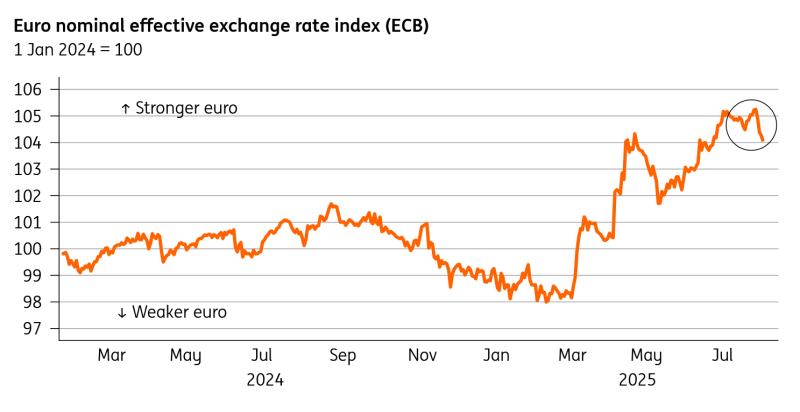
Our team are sticking to their rate cut call for now. But as Carsten wrote this week, if the worst is genuinely behind us on US tariffs and the economy begins to show signs of life, the debate could quickly turn to the timing of the first rate hike.
THINK Ahead in Developed Markets
United States (James Knightley)
US data: After July’s shock jobs report, the focus will be on whether individual Fed officials are becoming more favourable towards a September rate cut. Michelle Bowman and Christopher Waller have already both voted for a rate cut, and they are visibly concerned about the jobs data. In terms of the data, the is the key activity report and should show modest improvement based on evidence from regional surveys. Meanwhile, the surprise narrowing of the goods deficit should mean that the overall trade deficit also improves.
Canada (James Knightley)
Jobs report (Fri): With ongoing concerns about the implications of tariffs on all-important US-Canada trade, which accounts for around three-quarters of all Canadian exports, the data highlight will be the jobs report. We expect the economy to have maintained the surprise strength seen in the June employment data, but we see the risk of renewed weakness as we progress through the rest of the year.
United Kingdom (TADAWUL:) (James Smith)
Bank of England (Thur): The UK jobs market is creaking and that provides plenty of justification for a 25 basis point rate cut this month. But it’s a nuanced picture, which, set against sticky inflation data, suggests little reason for the Bank to open the door to a faster pace of easing next week. We expect a three-way vote split as the committee continues to prove divided.
THINK Ahead in Central and Eastern Europe
Hungary (Peter Virovacz)
Retail & Industry (Wed): Following the positive surprise regarding the Hungarian economy’s quarter-on-quarter performance in the second quarter, we expect industrial production and retail sales to show real monthly growth. However, retail sales growth remains limited due to a lack of consumer confidence, and the bottoming out for industry is just the start of a long road to slow recovery.
Inflation (Fri): In our view, the trend of subdued monthly repricing will continue. The stronger forint, lower imported inflation (tradables), lower fuel prices and seasonality will all play a significant role. In contrast, food inflation, particularly that relating to unprocessed food, will remain high due to supply-side shocks. Base effects should also provide support in terms of year-on-year figures this time, meaning that inflation could drop to 4.0% for the first time since late 2024. As inflation will mostly be driven by non-core items, core inflation could remain unchanged on a monthly basis. This, combined with the high base, will likely result in year-on-year core inflation at its lowest since summer 2021.
Czech Republic (David Havrlant)
Inflation (Tues): We expect July’s annual inflation to have softened, with core inflation also coming in milder than in the previous month. However, the food inflation forecast is challenging during the summer months, as there is a choppy dynamic in fruit and vegetable prices. The July food inflation print will depend on how far the bumpy path for potato prices is reflected in the CPI statistics. We take the view that the drop in July’s potato prices will be visible in the month’s consumer prices.
Retail & Industry (Wed/Thur): Both June’s industrial production and real retail sales likely maintained a decent annual growth rate, with consumers steadily outperforming the manufacturers. Spenders benefited from decent nominal and real wage growth, as well as upbeat confidence. Producers still face challenges, but have likely left the worst behind.
Rate decision (Thur): The Czech National Bank will likely leave rates unchanged at its Thursday afternoon meeting, as growth prospects (among other factors) have improved due to reduced uncertainty in the light of recent trade agreements. This implies mounting inflationary pressures when looking ahead, be it from relative tightness of the labour market or an upbeat housing market that may prompt rent increases and foster core inflation. The recent cutting cycle seems to be over.
Turkey (Muhammet Mercan)
Inflation (Mon): Against the backdrop of a 25% price hike, automatic tax adjustments (on alcohol, tobacco and fuel prices), and the lira’s depreciation vs the euro (weighing on auto/white goods prices), we expect July’s monthly inflation at 2.5%. However, favourable base effects would mean a deadline in annual inflation to 34.1% (from 35% a month ago).
Armenia (Dmitry Dolgin)
Rate decision (Tues): The Central Bank of Armenia will make a policy rate decision on Tuesday. We believe the decision will be between cutting to 6.50% and holding at 6.75%. We find a cut to be a more likely option due to slowing CPI and weakening economic growth amid a persistently strong currency performance and relatively balanced banking sector dynamics.
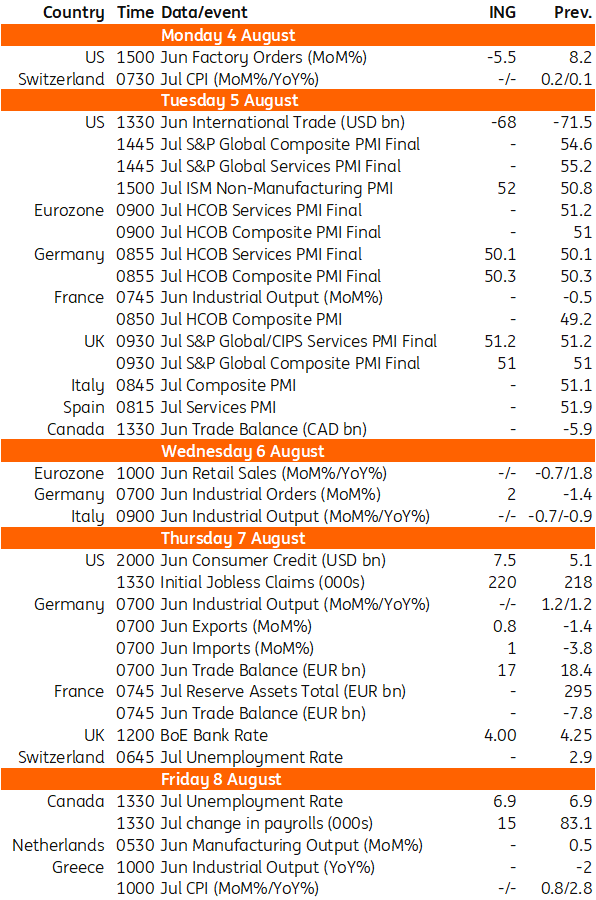
Key Events in EMEA Next (LON:) Week
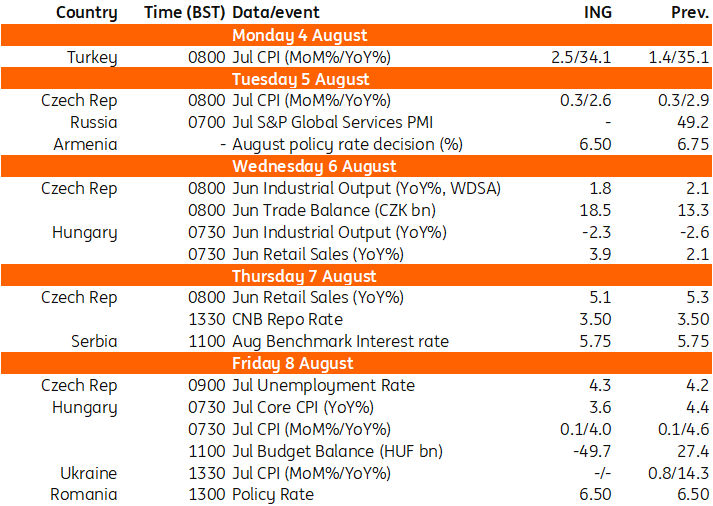
***
Disclaimer: This publication has been prepared by ING solely for information purposes irrespective of a particular user’s means, financial situation or investment objectives. The information does not constitute investment recommendation, and nor is it investment, legal or tax advice or an offer or solicitation to purchase or sell any financial instrument. Read more

